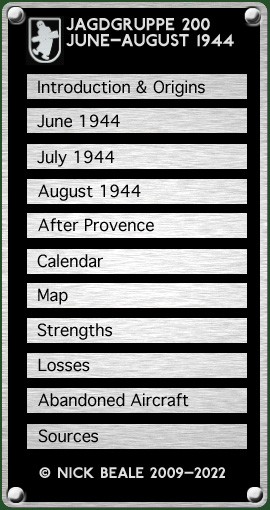|
On 1 August, three patrols were flown between 11.10 and 12.41 hours over Marseille–Toulon–Nice area, one such formation landing at 11.23. Another group was up over the Salernes–Brignoles area late in the afternoon but there were no contacts reported even though Signals Intelligence interpreted these flights as responses to Allied reconnaissance missions. Overheard on the “Trumpet/Fighter” network were:
Jagdgruppe 200 put up 13 sorties on the 2nd, the first group of aircraft scrambling at mid-morning (as the Allies deduced from their R/T traffic). The second formation was aloft at 12.35 hours, in response to a raid by the B-17s of the 301st BG on the oil storage facilities at Le Pouzin (in the Rhône Valley between Montélimar and Valence). Seven Bf 109s reported contact but made little impression on the Americans who judged them "not aggressive." Obergefreiter Ludwig Kumpf (1. Staffel) and Uffz. Kniestedt fell foul of the escorting P-51s of the 31st FG and in "a brief skirmish", about 60 km. north east of Marseille, both were shot down, Kumpf being killed and Kniestedt bailing out with slight injuries. The victorious American pilots were 1/Lt. Robert D. Thompson and 2/Lt. Roger H. Zierenberg, both of the 309th FS; the Germans made no claims against either bombers or fighters.
The lost aircraft seem to have been Bf 109 G-6 W.Nr. 163687 and 441734. While it is not known which one belonged to which pilot, it is recorded that Kumpf's machine was "white 2." A third Bf 109 (W.Nr. 163349) was 15% damaged and marked for factory repair but the cause of this is not clear since the Luftwaffe had taken to classifying its losses using four-letter codes which the Allies could not decipher. Another three Messerschmitts — W.Nr. 163472, 440646 and 441134 — were reported as "BEZU" probably some category of unavailability; the last of these aircraft was also reported to be “FENE” on 7 August).
Appearing in the Allied Signals Intelligence report for the day were:
At 21.30 hours that day the unit's strength report was interpreted by Allied Intelligence as 17 (3) aircraft and 31 (23) pilots. Since the "serviceable" figure of this and subsequent days is often lower than the numbers of aircraft flying a single mission, it seems possible either that the reports were being misread or the Germans were filling in their own forms wrongly. There is evidence of this again on 3 August when a fragmentary report indicated that three machines were serviceable at 18.30 hours but that there had been two scrambles during the day, totalling 10 sorties and that six Bf 109s had sighted hostile aircraft without success or loss. The 4th brought only one fruitless scramble by a pair of Bf 109s, from 12.08–12.45 hours, while on the following day there were signs of a late afternoon patrol over Southern France. Total aircraft strength was up to 19, there were 30 (23) pilots and II. Jagdkorps advised that Bf 109 G-6 W.Nr. 163552, currently in the workshop at Mondesir (a small aerodrome 10 km. south west of Étampes) had been allocated to JGr. 200; the Gruppe had also been assigned four Bf 109s from Hptm. Öls' rear detachment of JG 27 at Champfleury but would have to collect them itself. Finally, the day's strength return mentioned Bf 109 G-6s W.Nr. 411785 and 412523 in Paris, the context suggesting that these too had been allocated to the unit.
continued on next page …
|
|||||||||||||||||||||||||||||||||||||||||||||||||||||||||||||||||||||||||||||||||||||||||||||||||||||||||||||||||||||||||||||||||

